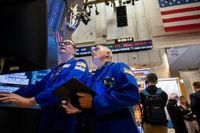As the U.S. financial markets open for another consequential week, a potent mix of optimism and anxiety is shaping the mood on Wall Street. Investors are juggling a surge in third-quarter earnings reports, delayed but highly anticipated inflation data, and the persistent drag of a government shutdown now stretching into its third week. The stakes? Nothing less than the direction of the world’s largest economy—and the portfolios of millions of Americans.
On Monday, October 20, 2025, U.S. stock futures pointed higher, with the Dow Jones Industrial Average futures up 0.2%, S&P 500 futures gaining 0.3%, and Nasdaq 100 futures climbing 0.4%, according to Yahoo Finance. This followed a week of gains capped by Friday’s rally, which was sparked in part by President Donald Trump’s softer tone on U.S.-China trade tensions. In an interview aired Sunday, Trump declared, “I’m not looking to destroy China,” a notable shift from his more combative stance in August. The administration had recently exempted dozens of products from tariffs and hinted that more duties could be lifted, fueling hopes among traders that the threatened 100% tariff on Chinese imports scheduled for November 1 might be averted.
“Relations with Beijing have de-escalated,” Treasury Secretary Scott Bessent told reporters, adding that he expects to meet with Chinese Vice Premier He Lifeng this week. This meeting is seen as a prelude to a high-stakes encounter between Trump and Chinese President Xi Jinping at a regional summit in South Korea at the end of October, as reported by CNBC. The market has been highly sensitive to any signs of thawing in the U.S.-China relationship, with recent rebounds in major indices driven as much by sentiment as by economic fundamentals.
Yet, beneath the surface, the picture remains complicated. The U.S. government shutdown has now entered its third week, with Democrats and Republicans locked in a stalemate over federal healthcare subsidies. This impasse has halted the release of crucial economic data, including jobs and inflation figures, which are essential for the Federal Reserve’s interest rate decisions. The Bureau of Labor Statistics is finally set to release September’s Consumer Price Index (CPI) on Friday, October 24, after recalling key personnel—a delay that has left investors and policymakers in an information vacuum.
Economists expect the CPI to show a 0.4% monthly increase, matching August’s pace, and a 3.1% annual rise, up from 2.9% in August. If realized, this would mark the fastest headline inflation rate in 17 months, according to MarketMinute. The core CPI is also projected to hold steady at 3.1% year-over-year. These numbers will be pivotal: stubbornly high inflation could force the Fed to reconsider its widely anticipated 25-basis-point rate cuts planned for both October and December, with the next policy decision scheduled for October 29. The central bank’s balancing act—taming inflation while supporting growth—has rarely felt so precarious.
Meanwhile, the third-quarter earnings season is hitting its stride. Heavyweights like Netflix, Coca-Cola, Tesla, Intel, IBM, and Texas Instruments are all reporting this week. Early results have been surprisingly robust: about 78% of S&P 500 companies that have reported so far have beaten earnings forecasts, and 22% have issued positive guidance—the highest rate in a year, according to MarketMinute. The S&P 500 is projected to post 8.0% year-over-year earnings growth and 6.3% revenue growth for the quarter, a testament to corporate resilience in the face of macroeconomic headwinds.
Financial institutions have led the charge, with Morgan Stanley and Bank of America both exceeding analyst projections on the back of strong deal-making activity. Tech giants with diversified revenue streams and strong pricing power, such as Microsoft and Apple, are also expected to perform well. “Companies that can pass on increased costs or benefit from continued digital transformation are typically more resilient,” noted analysts at Bloomberg.
However, not all sectors are poised to benefit. Retailers and manufacturers with thin margins or heavy reliance on discretionary spending could face headwinds if inflation continues to eat into consumer purchasing power. The manufacturing sector, particularly those with complex supply chains and high energy costs, may also struggle if input prices remain elevated. Companies that have seen their stock prices soar on high expectations—especially in the AI and electric vehicle spaces—could be vulnerable to sharp corrections if their earnings guidance disappoints.
The upcoming earnings from Tesla and Netflix are seen as bellwethers. Tesla’s performance will shed light on the health of the automotive sector and consumer willingness to buy big-ticket items amid inflation. Netflix’s results will offer a window into entertainment spending and the competitive streaming landscape. “The guidance these companies provide will be crucial for setting the tone for the rest of the year,” said a strategist at Reuters.
Beyond individual companies, the interplay between robust earnings and persistent inflation is creating a bifurcated landscape. Sectors with strong pricing power and efficient cost management are likely to outperform, while those exposed to rising costs or weakening demand may lag. The CBOE Volatility Index (VIX), Wall Street’s so-called “fear gauge,” surged to a nearly six-month high on October 18, underscoring the market’s underlying fragility.
The broader economic narrative is equally complex. The delayed CPI report has left the Federal Reserve and investors flying partially blind, complicating monetary policy decisions at a time when clarity is desperately needed. The ongoing government shutdown further muddies the waters, recalling past episodes of fiscal brinksmanship that led to short-term market instability and long-term policy uncertainty.
Looking ahead, the release of the CPI data on October 24 and the Fed’s policy decision on October 29 will be pivotal moments. A hotter-than-expected inflation reading could force the Fed’s hand, potentially triggering a reassessment of rate cut probabilities and sparking renewed market volatility. Conversely, if inflation appears to be moderating and corporate guidance remains upbeat, the market could sustain its recent momentum, buoyed by the prospect of lower interest rates and continued earnings growth.
In the longer term, companies will need to adapt to an environment where inflation may prove more persistent than hoped. This could mean increased investment in automation, supply chain diversification, and innovative products that command premium prices. Firms with strong balance sheets, diversified revenue streams, and a clear strategy for managing costs will likely emerge as winners.
For now, the market remains at a crossroads—caught between the promise of strong corporate profits and the perils of inflation and political gridlock. Investors, policymakers, and corporate leaders alike are watching closely, knowing that the decisions made in the coming weeks could set the tone for the economy well into 2026.






